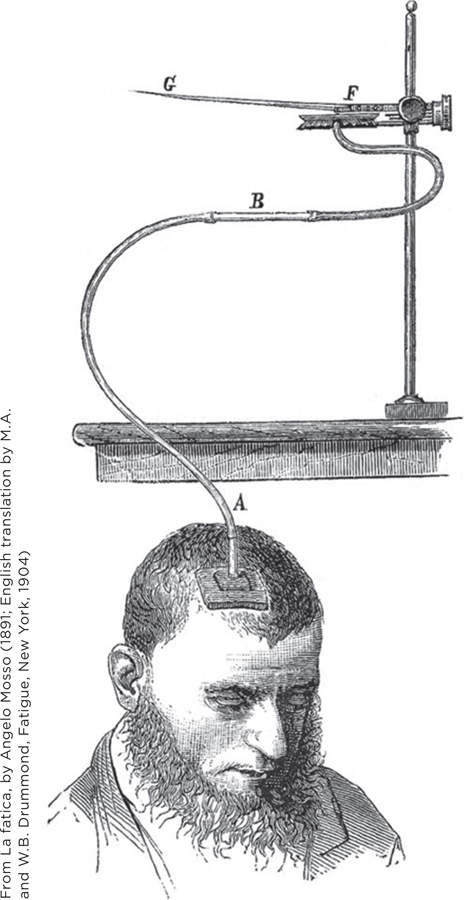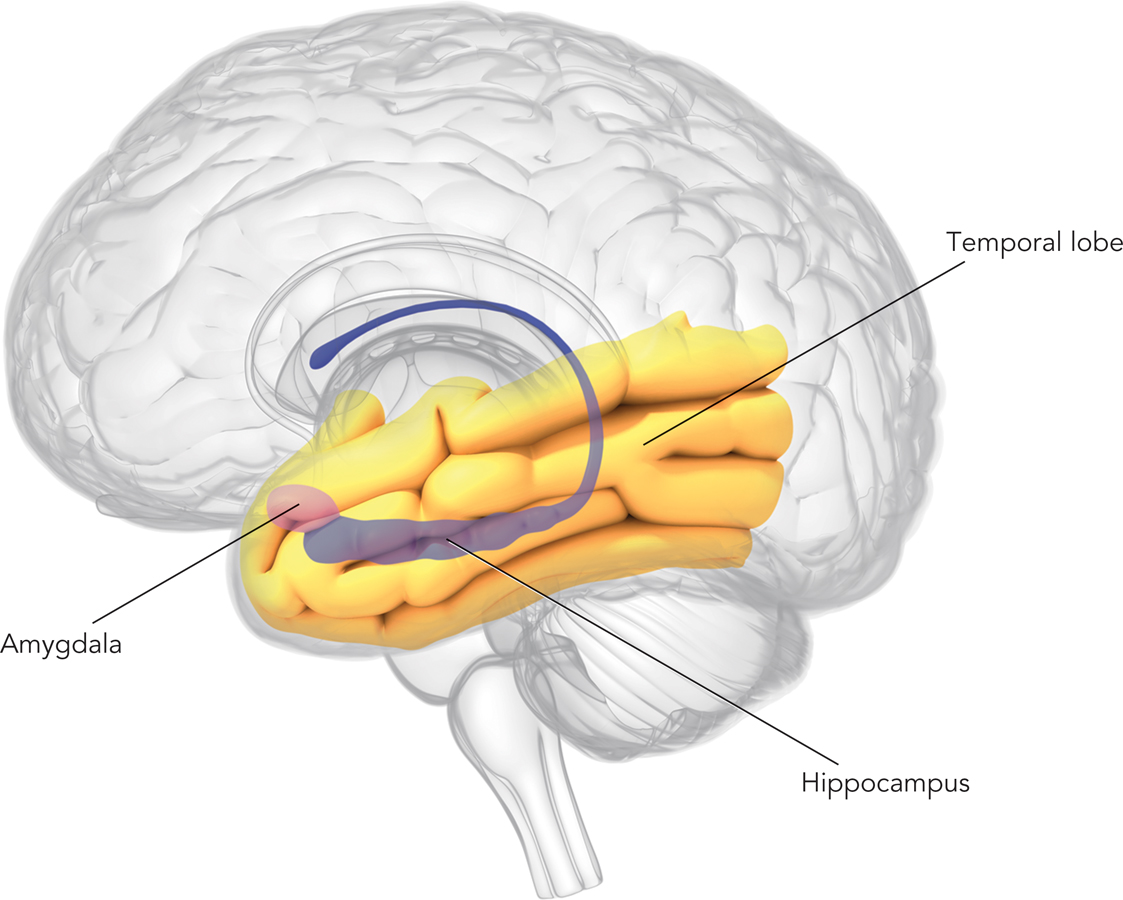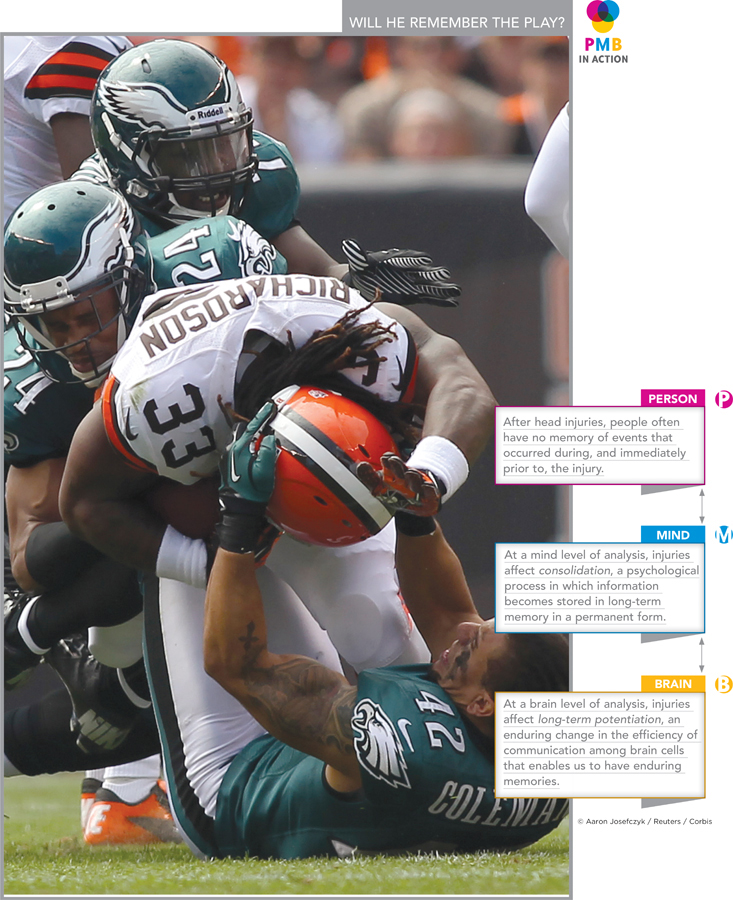6.6 Memory and the Brain
This chapter has so far been psychological rather than biological. We have explored psychological processes through which people achieve a mental ability: memory. But memory also rests on a piece of physical hardware: the brain. Let’s now move down a level of explanation, from mind to brain, and learn about the neural systems that underpin the psychological skills of memory.
Which part of the brain do you think is responsible for memory? Recall that the mind contains different memory systems (e.g., short-term, long-term) and retains different types of knowledge (semantic memory, episodic memory, procedural memory). This fact about the mind is relevant to our question about the brain. No one part of the brain is solely responsible for memory. Rather, different types of memory draw on different brain systems (Squire & Wixted, 2011).
Let’s look at brain systems underlying three memory abilities: (1) maintaining information in working memory; (2) forming permanent memories, that is, memories that last longer than the brief duration of working memory; and (3) representing knowledge in a permanent manner.
Working Memory and the Frontal Lobes
Preview Question
Question
 What part of the brain is active when we concentrate on and manipulate information?
What part of the brain is active when we concentrate on and manipulate information?

figure 6.15 Angelo Mosso’s apparatus for measuring blood flow in Michele Bertino’s brain.
Way back in April 1881, the book review section of Brain: A Journal of Neurology informed readers of a remarkable book by an Italian scientist, Angelo Mosso (Rabagliati, 1881). Mosso described the case of Michele Bertino, a gentleman whose misfortune was to be located 45 feet below a rooftop workman who dropped a brick. As Mosso related, Bertino survived the accident; in fact, mentally he was perfectly fine. The falling brick, however, created a 1-inch-diameter circular hole in his skull, just above and behind his forehead. By peering through the hole, one could see pulsations of blood in the frontal lobes of Bertino’s brain.
Mosso recognized that the accident, although bad news for Bertino, might be good news for science. Systematic observations of blood flow to the front of Bertino’s brain could provide insight into the biology of thinking.
Mosso rigged up a device for measuring the blood flow in Bertino’s frontal lobes. This was, in essence, like taking Bertino’s pulse—but the pulse of blood flow in the brain rather than at the wrist (Figure 6.15). Mosso observed that when Bertino concentrated on information, blood flow increased. When he solved an arithmetic problem, or was criticized for making an error, or was suddenly reminded of some activity he was supposed to be engaged in, more blood flowed to his frontal lobes. Mosso’s analysis provided unique evidence that the frontal lobes are involved in thinking.
In contemporary scientific language, what Mosso observed is that the frontal lobes underpin working memory, the mental system that enables us to concentrate on, and consciously manipulate, small amounts of information. Contemporary evidence supports Mosso’s observation. In one study, researchers obtained brain images while research participants performed two tasks. One task was so easy that it required little working-memory activity: Participants simply counted the numbers 1 through 10, in order. The other task required more working-memory action: They were asked to generate random orderings of the digits 1 through 10, being careful not to repeat a digit. When the researchers compared brain activity during the two tasks (Petrides et al., 1993), they found that working-memory activity was associated with activation in the frontal lobes.
WHAT DO YOU KNOW?…
Question
14
Contemporary research corroborates Mosso’s observation that thinking—in particular, working-memory activity—is associated with increased activity in the frontal 2BRIwjzqy9Y9g65b.
The Hippocampus and the Formation of Permanent Memories
Preview Questions
Question
 What brain systems are critical for the formation of more permanent memories?
What brain systems are critical for the formation of more permanent memories?
How can they be enhanced?
Question
 What brain system is critical for our ability to make cognitive maps?
What brain system is critical for our ability to make cognitive maps?
Information in working memory does not stay there for long. In the working-memory experiment we just reviewed, participants likely forget any given string of random numbers they had generated within a minute or less. What brain systems enable you to form more permanent memories?
The key systems are found in the temporal lobes, the large sections of brain matter on the right and left sides of the brain, located under the skull just above the ears. Scientists have known since 1953 that the temporal lobe is needed for forming permanent memories—that’s the year HM had his surgery and lost his memory, as you might recall from this chapter’s opening story. That surgery damaged brain matter in HM’s temporal lobe. Later in HM’s life, newly developed technologies enabled researchers to create images of his brain; those images confirmed the existence of long-term temporal lobe damage (Corkin et al., 1997)—a conclusion further confirmed by postmortem dissections of HM’s brain (Worth & Annese, 2012).
Within each temporal lobe is a structure that contributes directly to the formation of permanent memories: the hippocampus (Figure 6.16). Research on the hippocampus provides insight, at a brain level of analysis, into a mental process you learned about earlier: consolidation, or the transformation of memories that are fragile into ones that are permanent (Squire, 1992). Consolidation occurs thanks to a biological process in the hippocampus known as long-term potentiation. Long-term potentiation is an enduring increase in the efficiency of communication between brain cells (Bliss & Collingridge, 1993). Cell-to-cell communications become more efficient, due to changes in the biochemical processes through which brain cells influence one another’s firing (McIntyre, McGaugh, & Williams, 2012). These long-lasting changes in the brain enable organisms to have long-lasting memories. The biological changes occur only gradually, which is why the psychological process of consolidation is gradual.

figure 6.16 Hippocampus and temporal lobe
Long-term potentiation helps explain the effects of head injuries on memory (discussed earlier). Head injuries, such as those that occur in contact sports, can disrupt the biochemical processes required for long-term potentiation to occur (De Beaumont et al., 2012). As a result, the formation of long-term memories is disrupted (Figure 6.17).

figure 6.17 WILL HE REMEMBER THE PLAY? 
Changes in the hippocampus across the life span produce changes in memory ability. The hippocampus often shrinks in size in older adulthood, and older adults with smaller hippocampus volume have relatively poor semantic memory (Zimmerman et al., 2008). Conversely, increases in hippocampus size improve memory. In one study, older adults participated in a year-long program of aerobic exercise, that is, exercise that moderately increases heart rate for extended periods of time. Compared with a group that did not exercise aerobically, aerobic exercisers had a larger hippocampus and better memory (Erickson et al., 2011).
How much aerobic activity do you engage in during a given week?

Get that hippocampus going! Research shows that exercise classes can increase the size of the hippocampus, as well as memory ability, among older adults.
One form of memory for which the hippocampus is particularly critical is spatial memory, which is the ability to recall the layout of one’s physical environment. Complex mammals have good spatial memory, thanks to their ability to create cognitive maps (Tolman, 1948). Cognitive maps are mental representations of a physical layout. The hippocampus is key to cognitive map making (Nadel, 1991). Evidence of its role comes from research in which the hippocampus is damaged. Consider research with homing pigeons, a species that has excellent spatial memory. If a young pigeon’s hippocampus is damaged, its ability to find its way home—or anywhere else—is substantially impaired (Nadel, 1991).
The hippocampus is not the only brain system that contributes to the formation of enduring memories. Another is the amygdala, which is located very close to the hippocampus (see Figure 6.16) and which also takes part in creating permanent memories (Bermudez-Rattoni, 2010). It appears to play a larger role in memory formation when people do not think deeply about material—that is, when they engage in shallow processing (Figure 6.5). Thanks to amygdala activation, people may remember emotionally significant material even when their initial processing of the material was shallow (Ritchey, LaBar, & Cabeza, 2011).
WHAT DO YOU KNOW?…
Question
15
HM, who could not form permanent memories, suffered from damage to the hippocampus, a structure located in the PNFV1njeGXJwOgC6JZm0DA== lobe. The hippocampus is particularly important to consolidation, which occurs as a result of the biological process of long-term VI5bDxwubFe7RWuv2TsUkHNn1sI=, whereby cell-to-cell communication is made more efficient due to biochemical changes. The hippocampus is particularly important to the formation of 5nBD6UhwnDbxd2IX memory, the ability to recall the layout of one’s physical environment. The XXrTlZEqkB70qv+z3zFo3w==, which is near the hippocampus, also aids in the formation of permanent memories.
The Distributed Representation of Knowledge
Preview Question
Question
 Does the way information is stored in the brain resemble the way a book is stored in a library?
Does the way information is stored in the brain resemble the way a book is stored in a library?
The hippocampus is key to the formation of permanent memories, that is, the process in which a given memory becomes permanently stored. But once that permanent storage occurs, the hippocampus’s role is less important. Other brain regions take part in permanent memory storage—especially regions of the brain’s outermost layer of cells, the cerebral cortex (Squire & Wixted, 2011; see Chapter 3).
How is any given memory stored in the cerebral cortex? There are two possibilities. One is that the brain works like a library. Your brain retains information, and libraries store information—for example, the information in a book. In a library, any given book is stored in a particular location. In other words, the whole book—every word and picture—is stored in one given place. Does your brain work like this, storing all your memory about a person, place, or experience in one biological spot under the skull?
In a word, no. Instead, the brain primarily works according to a second principle of information storage: distributed storage. When you remember an experience—its sights and sounds, how it felt, and factual information identifying the people and places you experienced—you activate multiple regions in the brain. The overall pattern of brain activation provides the memory (Schacter, 1996). The knowledge you retain about the experience, then, is distributed across multiple parts of the brain.
Psychologists who have advanced parallel distributed processing models of memory (discussed above) have shown how and where this psychological processing can occur in the brain (McClelland & Rogers, 2003). Their model (Figure 6.18) identifies multiple parts of the brain that become active when you try to remember something.

figure 6.18 Distributed brain systems Memories are not stored in one location in the brain. They are distributed across different brain regions. In this model of memory and the brain (McClelland & Rogers, 2003), neural activity in the temporal lobe coordinates activity in other brain regions that process the sights, sounds, and actions that come to mind when you remember your experiences.
Suppose you’re trying to remember something about a movie; perhaps someone asks you, “How did you like Johnny Depp in Pirates of the Caribbean?” and you’re trying to activate a memory of his performance to answer the question. There is no one spot—no single location—in your brain that contains the “memory of Johnny Depp in Pirates of the Caribbean.” Instead, memories of what he looked like, how he sounded, how he moved, and so forth are represented in different locations of the brain. Activity in the different locations has to be coordinated, so the different features come to mind all at once and give you a complete, coherent memory. In this theoretical model, the coordination occurs as a result of activity in the temporal cortex (McClelland & Rogers, 2003). The coordinated activity provides you with your memory of Captain Jack Sparrow.
WHAT DO YOU KNOW?…
Question
16
zcA7Pgm8c8nU61a+w+9mwYDGv0+hbUuGRBnN6gKxK6zA5UNSxvZSfilRF90dmLbZLHi6AOrJokA82cDFE3B/5Wzb+NrRLxltvs0T2aKfG0jeWei4vaiKPuok0XGBtzpKVgyFk+D2JNq3vlVbU39j63TwyHFvG1SVz80/1jlRMsLg1aDorPeg34tRQjZgWVRGvWAjABlc7sJljZRgTsEcZg==
According to parallel distributed processing models of memory, activity in the temporal cortex works to coordinate these different memories so you experience a coherent whole.
 What part of the brain is active when we concentrate on and manipulate information?
What part of the brain is active when we concentrate on and manipulate information?
 What brain systems are critical for the formation of more permanent memories?
What brain systems are critical for the formation of more permanent memories? What brain system is critical for our ability to make cognitive maps?
What brain system is critical for our ability to make cognitive maps?



 Does the way information is stored in the brain resemble the way a book is stored in a library?
Does the way information is stored in the brain resemble the way a book is stored in a library?